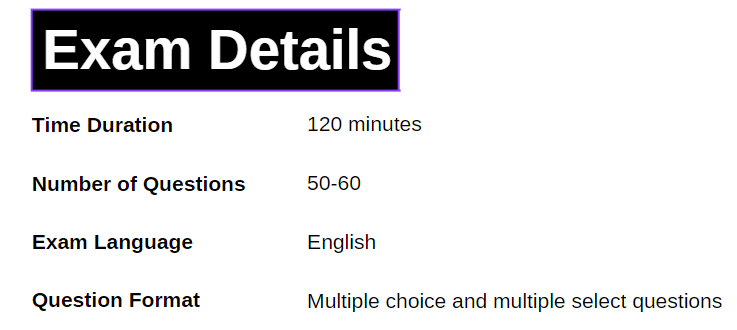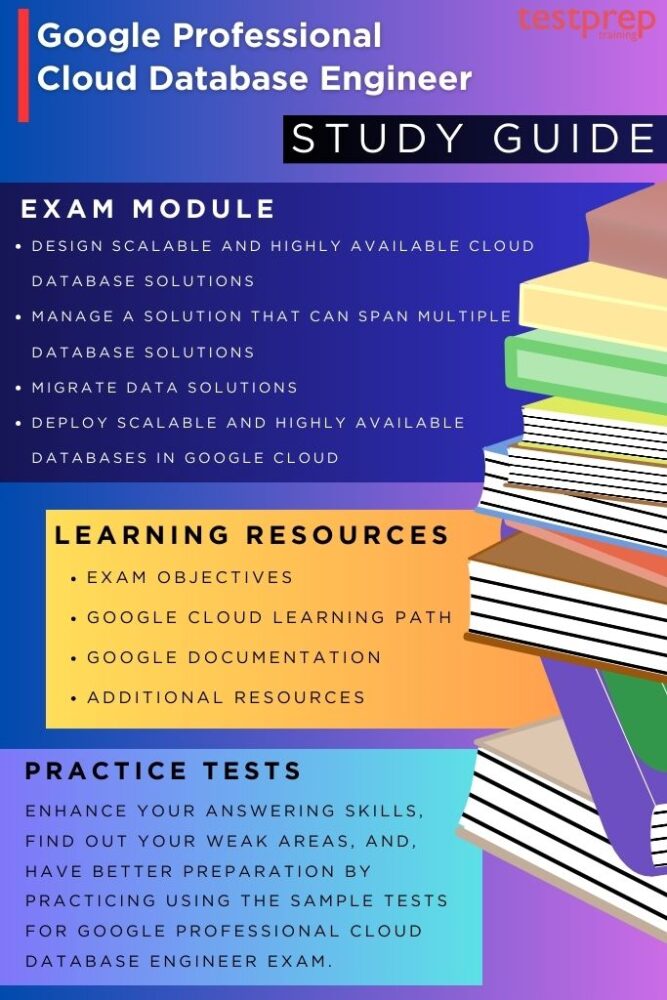Google Professional Cloud Database Engineer

The Professional Cloud Database Engineer exam targets database experts with two years of experience on Google Cloud and five years in overall database and IT roles. This role involves designing, building, managing, and troubleshooting Google Cloud databases for application data storage and retrieval. A Professional Cloud Database Engineer should be adept at converting business and technical needs into efficient and scalable database solutions. The exam evaluates your proficiency in:
- Designing scalable and highly available cloud database solutions
- Managing solutions that integrate multiple database systems
- Migrating data solutions
- Deploying scalable and highly available databases on Google Cloud
Recommended experience:
Candidates for the Professional Cloud Database Engineer exam should have over 5 years of experience in database and IT roles, with at least 2 years of practical experience using Google Cloud database solutions.
Exam Details

The Google Professional Cloud Database Engineer exam lasts two hours and costs $200 (plus applicable taxes) to register. The exam is conducted in English and consists of 50-60 questions, which include multiple-choice and multiple-select formats. You can take the exam online with remote proctoring or in-person at an authorized testing center.
Exam Register
Here’s how you can schedule an exam:
- Visit the Google Cloud website and click on “Register” for the exam you want to take.
- Google Cloud certifications are available in various languages, and you can find the list on the exam page. If you’re a first-time test taker or prefer a localized language, create a new user account in Google Cloud’s Webassessor in that language.
- During registration, choose whether you want to take the exam online or at a testing facility nearby. The Exam Delivery Method includes:
- Taking the online-proctored exam from a remote location. Make sure to check the online testing requirements first.
- Taking the onsite-proctored exam at a testing center. You can locate a test center near you.
Exam Course Outline
The exam guide has a list of subjects that might be in the test. Here are the specific subjects:

Section 1: Design scalable and highly available cloud database solutions (42%)
1.1 Analyze relevant variables to perform database capacity and usage planning. Activities include:
● Given a scenario, perform solution sizing based on current environment workload metrics and future requirements (Google Documentation: Migrate to Google Cloud: Assess and discover your workloads)
● Evaluate performance and cost tradeoffs of different database configurations (machine types, HDD versus SSD, etc.) (Google Documentation: Choose between SSD and HDD storage)
● Size database compute and storage based on performance requirements (Google Documentation: Configure disks to meet performance requirements)
1.2 Evaluate database high availability and disaster recovery options given the requirements. Activities include:
● Evaluate tradeoffs between multi-region, region, and zonal database deployment strategies (Google Documentation: Geography and regions, Multi-regional deployment on Compute Engine)
● Given a scenario, define maintenance windows and notifications based on application availability requirements (Google Documentation: Maintenance windows and exclusions)
● Plan database upgrades for Google Cloud-managed databases (Google Documentation: Upgrade the database major version in-place)
1.3 Determine how applications will connect to the database. Activities include:
● Design scalable, highly available, and secure databases (Google Documentation: Design for scale and high availability)
● Configure network and security (Cloud SQL Auth Proxy, CMEK, SSL certificates) (Google Documentation: Configure SSL/TLS certificates, Cloud SQL Auth Proxy)
● Justify the use of session pooler services (Google Documentation: Sessions)
● Assess auditing policies for managed services (Google Documentation: Organization Policy audit logging)
1.4 Evaluate appropriate database solutions on Google Cloud. Activities include:
● Differentiate between managed and unmanaged database services (self-managed, bare metal, Google-managed databases and partner database offerings)
● Distinguish between SQL and NoSQL business requirements (structured, semi-structured, unstructured)
● Analyze the cost of running database solutions in Google Cloud (comparative analysis) (Google Documentation: Comparative analysis of Google Cloud deployment archetypes)
● Assess application and database dependencies (Google Documentation: Migrate to Google Cloud: Assess and discover your workloads)
Section 2: Manage a solution that can span multiple database solutions (34%)
2.1 Determine database connectivity and access management considerations. Activities include:
● Determine Identity and Access Management (IAM) policies for database connectivity and access control (Google Documentation: Identity and Access Management (IAM))
● Manage database users, including authentication and access (Google Documentation: Manage users with built-in authentication, Manage users with IAM database authentication)
2.2 Configure database monitoring and troubleshooting options. Activities include:
● Assess slow running queries and database locking and identify missing indexes (Google Documentation: Use Query Insights to improve query performance)
● Monitor and investigate database vitals: RAM, CPU storage, I/O, Cloud Logging (Google Documentation: Cloud Logging overview)
● Monitor and update quotas (Google Documentation: View and manage quotas)
● Investigate database resource contention (Google Documentation: Troubleshooting resource contention issues, Introspection tools overview)
● Set up alerts for errors and performance metrics (Google Documentation: Create metric-threshold alerting policies)
2.3 Design database backup and recovery solutions. Activities include:
● Given SLAs and SLOs, recommend backup and recovery options (automatic scheduled backups) (Google Documentation: Backups overview, Create and manage on-demand and automatic backups)
● Configure export and import data for databases (Google Documentation: Exporting and Importing Entities)
● Design for recovery time objective (RTO) and recovery point objective (RPO) (Google Documentation: Disaster recovery planning guide)
2.4 Optimize database cost and performance in Google Cloud. Activities include:
● Assess options for scaling up and scaling out. (Google Documentation: Autoscaling groups of instances)
● Scale database instances based on current and upcoming workload (Google Documentation: Scaling based on schedules)
● Define replication strategies (Google Documentation: Replication)
● Continuously assess and optimize the cost of running a database solution
2.5 Determine solutions to automate database tasks. Activities include:
● Perform database maintenance (Google Documentation: About maintenance on Cloud SQL instances)
● Assess table fragmentation (Google Documentation: Handle processing response)
● Schedule database exports (Google Documentation: Scheduling an Export)
Section 3: Migrate data solutions (14%)
3.1 Design and implement data migration and replication. Activities include:
● Develop and execute migration strategies and plans, including zero downtime, near-zero downtime, extended outage, and fallback plans (Google Documentation: Migrate to Google Cloud: Best practices for validating a migration plan)
● Reverse replication from Google Cloud to source (Google Documentation: Reverse and resume a replication)
● Plan and perform database migration, including fallback plans and schema conversion (Google Documentation: Database migration: Concepts and principles: Part 1 and Part 2)
● Determine the correct database migration tools for a given scenario (Google Documentation: Overview of Database Migration Service)
Section 4: Deploy scalable and highly available databases in Google Cloud (10%)
4.1 Apply concepts to implement highly scalable and available databases in Google Cloud. Activities include:
● Provision high availability database solutions in Google Cloud (Google Documentation: Enable and disable high availability)
● Test high availability and disaster recovery strategies periodically (Google Documentation: About disaster recovery (DR) in Cloud SQL)
● Set up multi-regional replication for databases (Google Documentation: Regional and multi-region configurations)
● Assess requirements for read replicas (Google Documentation: About read replicas)
● Automate database instance provisioning (Google Documentation: Create instances)
Google Professional Cloud Database Engineer Exam FAQs
Exam Policies
The Exam Policies are:
Certification Renewal / Recertification:
To maintain your certification status, recertification is required. Unless otherwise specified in the exam details, Google Cloud certifications are valid for two years. Recertification entails retaking and passing the exam within a designated period. You can begin the recertification process 60 days before your current certification expires.
Retake Exam:
Google ensures the integrity of its certified user group by enforcing exam security and strict testing rules. If you fail an exam, you can retake it after 14 days. If you fail the second attempt, a 60-day waiting period is required before you can try again. After failing the third attempt, you must wait 365 days before attempting the exam once more.
Cancellation and Reschedule Policy:
No refunds are given for missed exams. Cancelling less than 72 hours before an onsite exam or less than 24 hours before an online exam will forfeit your exam fee. Rescheduling within 72 hours of an onsite exam or within 24 hours of an online exam incurs a fee. To reschedule, log into your Webassessor account, select “Register for an Exam,” and choose “Reschedule/Cancel” from the Scheduled/In Progress Exams section.
Study guide for Google Professional Cloud Database Engineer Exam

1. Getting Familiar with Exam Objectives
To begin your preparation for the Professional Database Engineer exam, it’s essential to understand the exam objectives. These objectives encompass topics that form the core of the exam. Reviewing the exam guide is a critical step to gain a comprehensive understanding of these topics and to focus your study efforts effectively.
2. Database Engineer Learning Path
A Database Engineer is responsible for designing, creating, managing, migrating, and troubleshooting databases for applications to store and retrieve data. This learning path offers a curated selection of on-demand courses, labs, and skill badges, providing practical, hands-on experience with Google Cloud technologies essential for the role. After completing this path, explore our catalog of over 700 labs and courses to continue advancing your professional skills.
3. Google’s Documentation
Google’s documentation acts as an extensive guide that assists users in understanding the nuances of its products and services. Regardless of whether you’re a developer, a business professional, or an enthusiast, Google’s documentation offers comprehensive and precise guidance on leveraging their technologies efficiently. Covering a diverse array of subjects, including API references, implementation strategies, problem-solving techniques, and optimal approaches, the documentation is crafted to be accessible to users. It presents instructions and examples in a clear, step-by-step manner, facilitating easy comprehension and implementation of the provided information.
Additional resources:
- Your Google Cloud database options, explained
- Database modernization solutions
- Database migration solutions
- Google Cloud solutions
4. Practice Tests
Participating in practice exams for the Google Professional Cloud Database Engineer certification is vital for understanding the question format and potential topics that may appear on the exam. Engaging in these practice tests not only helps in getting accustomed to the exam structure but also significantly enhances your preparation efforts. These practice exams serve as valuable tools for pinpointing both your strengths and weaknesses, enabling you to concentrate on areas requiring improvement. Furthermore, practicing with these practice tests enhances your capability to respond promptly and accurately, thereby conserving precious time during the actual examination.



